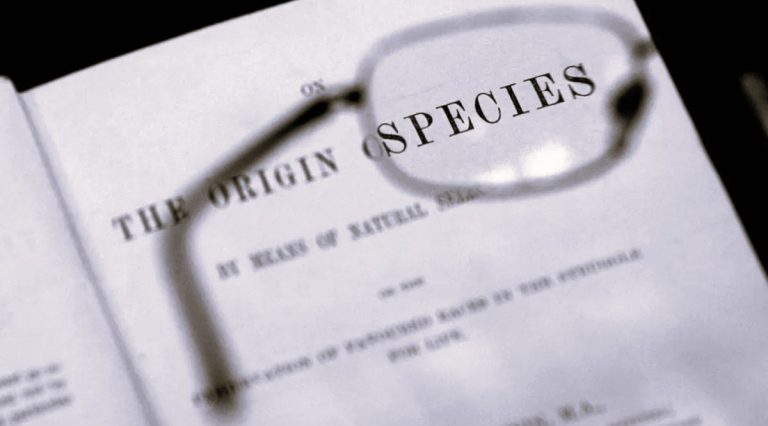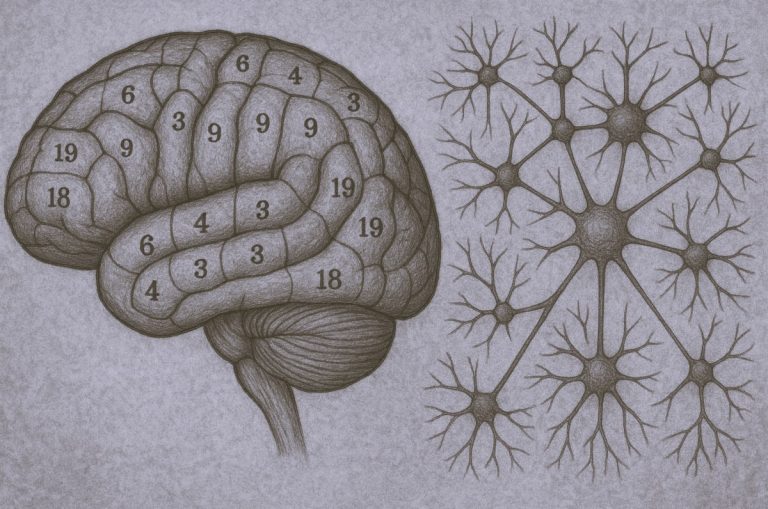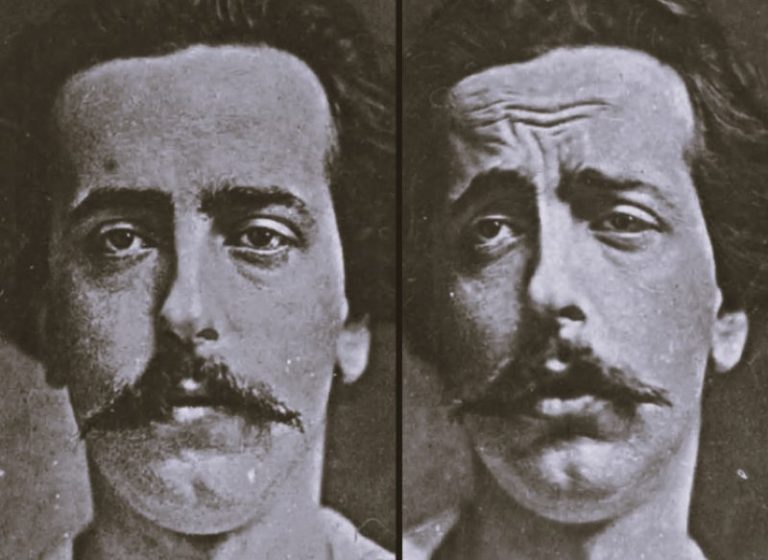
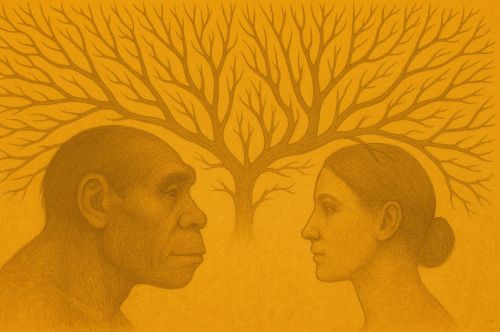
To write the history of human evolution is to confront the role of contingency. The growth of the brain, while extraordinary, was not predetermined.

By Matthew A. McIntosh
Public Historian
Brewminate
Introduction: Beyond the Ladder of Progress
Human evolution is often depicted as a tidy sequence of figures rising from stooped ape to upright man, a cultural shorthand that adorns textbooks, advertisements, and even political cartoons. Yet historians of science and paleoanthropologists alike caution against this simplification. The reality is far messier, more contingent, and more instructive. Evolution is not a march of progress but a branching, tangled process, one that produced not only Homo sapiens but also Neanderthals, Denisovans, and other hominin species whose shadows still linger in our DNA.
The historian must approach this subject critically, aware that narratives of inevitability often betray cultural desires rather than scientific realities. The development of the human brain, the symbol and substance of our species’ distinctiveness, was not foreordained. It emerged within particular ecological contexts, waxed and waned across species, and cannot be disentangled from the broader web of hominin diversity.
The Brain as a Driver of Human Evolution
Dramatic Growth and Environmental Pressures
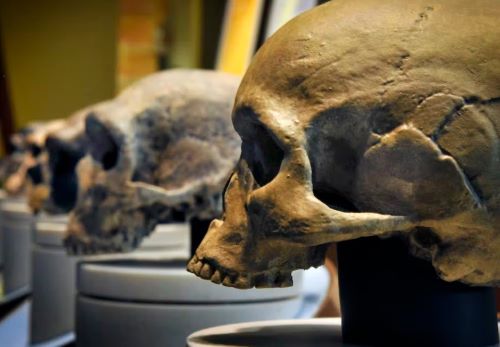
Picture East Africa nearly two million years ago: grasslands stretch under a shifting sky, and small bands of early Homo move between shrinking forests and open plains. The climate swings unpredictably from lush to arid, forcing constant adaptation. In such a world, survival required foresight. A brain able to recall past scarcity, imagine future migrations, and improvise new tools could mean the difference between life and extinction.
Over the course of millions of years, human brain size tripled, an astonishing expansion compared with our primate relatives. This rapid growth, particularly evident in the genus Homo, coincided with dramatic climate shifts during the Pleistocene epoch.1 In unstable environments, flexibility was at a premium. Larger brains allowed for greater adaptability, improved planning, and social complexity. To interpret the brain as a mere organ of thought is to understate its evolutionary role: it was a survival tool, as vital as opposable thumbs or bipedal locomotion.
The connection between environmental variability and brain growth may be compelling, but historians of science warn against easy determinism. The claim that climate instability drove brain expansion reflects broader cultural metaphors of struggle and resilience. Scientific hypotheses are often shaped by the historical imagination of their authors, who see in the past echoes of present anxieties about adaptation in times of upheaval.
There is also the issue of cost. A large brain demands enormous energy. Estimates suggest it consumes nearly twenty percent of the body’s total resources at rest. The fact that natural selection permitted such extravagance indicates how decisive the benefits must have been, but also reminds us that evolution is a process of trade-offs, not simple gains.
Information Processing and Social Worlds

The expansion of the brain afforded more than problem-solving in the face of environmental challenges. It enabled a new level of information storage and social navigation. Anthropologists note that larger group sizes demand more cognitive resources to track alliances, debts, and rivalries.2 The brain became not only a tool for survival but also an arena for culture, language, and symbolic expression.
This feedback loop between brain and society illustrates a more dynamic picture than linear growth. Cultural environments selected for sharper minds, which in turn produced more complex cultural environments. The brain’s story is thus not only evolutionary but historical: the interaction of biology with the lived realities of cooperation, competition, and communication.
Not an Inevitable Trend
The growth of the human brain was not universal. Homo floresiensis, discovered in Indonesia and nicknamed “the hobbit,” lived until roughly 50,000 years ago with one of the smallest brain sizes among hominins.3 Resource scarcity shaped its diminutive stature and cranial capacity. Its existence shows that evolution does not move toward a single goal but experiments with multiple strategies.
The very survival of such a species until so recently is a striking reminder that human history could have unfolded differently. Big brains were one solution, not the solution.
A Weblike Evolutionary History
The Branching Tree of Hominins
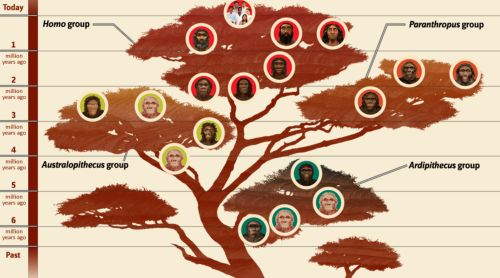
In 2003, deep within the Liang Bua cave on Flores Island, Indonesian and Australian archaeologists brushed away sediment to reveal the skull of a being both strange and familiar. Barely a meter tall, with cranial capacity no larger than a chimpanzee’s, Homo floresiensis challenged assumptions about the neat upward arc of brain size. Here was evidence of a branch that endured, small but resilient, while other giants of the genus vanished.
Human evolution is best visualized not as a ladder but as a branching tree. Multiple hominin species coexisted, diverged, and sometimes competed. Fossil evidence suggests that at points in history, at least four different human species walked the earth simultaneously.4
To embrace this image is to relinquish the comfort of inevitability. The linear model collapses plurality into a single line, obscuring the richness of our evolutionary story. The branching model insists on contingency: species rise and fall, not necessarily yielding to a “better” successor but sometimes vanishing due to climate, accident, or competition.
For the historian, this shift matters because it destabilizes the cultural habit of imagining evolution as a drama of ascent. It is instead a record of divergence and disappearance, of alternatives cut short.
Interbreeding and Shared DNA
The discovery that Homo sapiens interbred with Neanderthals and Denisovans has revolutionized our understanding of human history. Between one and four percent of the DNA of modern non-African humans derives from Neanderthals.5 In certain populations, Denisovan ancestry contributes to traits such as high-altitude adaptation among Tibetans.6
This complicates older narratives of “replacement,” in which Homo sapiens simply outcompeted others. The reality was entanglement. These species were not sealed off but engaged in intimate, generative contact. Identity and lineage were blurred. Evolution produced webs of kinship, not hard boundaries.
It is telling that this discovery came only with the advent of genetic sequencing. For decades, fossils alone suggested competition and succession. DNA revealed connection. The historian of science must observe how technology reshapes not only our understanding of the past but the metaphors with which we describe it.
Multiple Evolutionary Paths and the Vanishing of Species
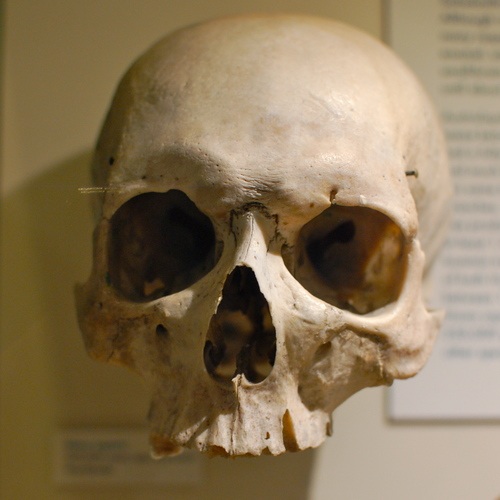
Imagine a band of Neanderthals in Ice Age Europe, gathered around a fire in a cave. They knap stone tools with practiced precision, while others tend to hides and prepare food. Their children play nearby. To those who discovered their remains tens of thousands of years later, such beings were long cast as brutish. Yet archaeology reveals sophistication: symbolic burials, possible art, and complex cooperation. They were not failed experiments but successful humans in their own right.
While Homo sapiens remains the only surviving branch, the success of others should not be discounted. Neanderthals thrived across Europe and western Asia for hundreds of thousands of years. Their cultural achievements, from tools to symbolic burials, challenge caricatures of them as brutish and unintelligent. Their disappearance 40,000 years ago remains a contested subject. Some argue climate shifts sealed their fate, others that competition with modern humans proved decisive.7
Homo erectus, by contrast, endured for nearly two million years. By that measure, our species is still in its adolescence. To imagine ourselves as the inevitable outcome of a grand narrative of progress is to forget how many successful species preceded us and how provisional our own dominance may be.
The extinction of these cousins also reminds us of the role of chance. A volcanic eruption, a change in rainfall patterns, or a shift in prey availability could alter destinies. Evolution does not reward superiority in abstract terms but adaptation to specific contexts. Survival is fragile, and history is filled with branches cut short.
Conclusion: The Contingency of Minds
In the present, a person of European descent might glance in the mirror without realizing that one to four percent of their DNA belongs not to Homo sapiens alone but to Neanderthals. A Tibetan herder, adapted to high mountain life, carries a gift of endurance shaped by Denisovan ancestry. The past is not buried; it lives on in the marrow of our bones and the code of our cells.
To write the history of human evolution is to confront the role of contingency. The growth of the brain, while extraordinary, was not predetermined. It carried costs as well as advantages, and its benefits were realized only in particular settings. The branching tree of hominin diversity reveals paths not taken, cousins lost, and mixtures preserved in our DNA.
The cultural persistence of the ladder of progress speaks to our desire for certainty. We want to imagine ourselves as the inevitable pinnacle, not the fortunate survivors of a crowded field. Yet the evidence undermines this comfort. We are the heirs of entanglement, the product of mixture, and the last branch standing on a tree that once spread wide.
That recognition ought to inspire humility. Our brains give us the capacity to narrate our own origins, to reconstruct the tangled webs that produced us. But they also tempt us into hubris, into assuming that intelligence guarantees permanence. History tells otherwise. The story of minds entwined across species is one of brilliance, fragility, and chance.
Appendix
Footnotes
- Rick Potts, “Environmental Hypotheses of Hominin Evolution,” Yearbook of Physical Anthropology 41 (1998): 93–136.
- Robin I. M. Dunbar, Grooming, Gossip, and the Evolution of Language (Cambridge: Harvard University Press, 1996), 89–94.
- Peter Brown et al., “A New Small-Bodied Hominin from the Late Pleistocene of Flores, Indonesia,” Nature 431, no. 7012 (2004): 1055–1061.
- Ian Tattersall, Masters of the Planet: The Search for Our Human Origins (New York: Palgrave Macmillan, 2012), 112–119.
- Svante Pääbo et al., “A Draft Sequence of the Neandertal Genome,” Science 328, no. 5979 (2010): 710–722.
- Emilia Huerta-Sánchez et al., “Altitude Adaptation in Tibetans Caused by Introgression of Denisovan-Like DNA,” Nature 512, no. 7513 (2014): 194–197.
- Chris Stringer, The Origin of Our Species (London: Penguin, 2012), 142–151.
Bibliography
- Brown, Peter, et al. “A New Small-Bodied Hominin from the Late Pleistocene of Flores, Indonesia.” Nature 431, no. 7012 (2004): 1055–1061.
- Dunbar, Robin I. M. Grooming, Gossip, and the Evolution of Language. Cambridge: Harvard University Press, 1996.
- Huerta-Sánchez, Emilia, et al. “Altitude Adaptation in Tibetans Caused by Introgression of Denisovan-Like DNA.” Nature 512, no. 7513 (2014): 194–197.
- Pääbo, Svante, et al. “A Draft Sequence of the Neandertal Genome.” Science 328, no. 5979 (2010): 710–722.
- Potts, Rick. “Environmental Hypotheses of Hominin Evolution.” Yearbook of Physical Anthropology 41 (1998): 93–136.
- Stringer, Chris. The Origin of Our Species. London: Penguin, 2012.
- Tattersall, Ian. Masters of the Planet: The Search for Our Human Origins. New York: Palgrave Macmillan, 2012.
Originally published by Brewminate, 08.26.2025, under the terms of a Creative Commons Attribution-NonCommercial-NoDerivatives 4.0 International license.
